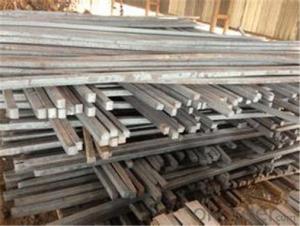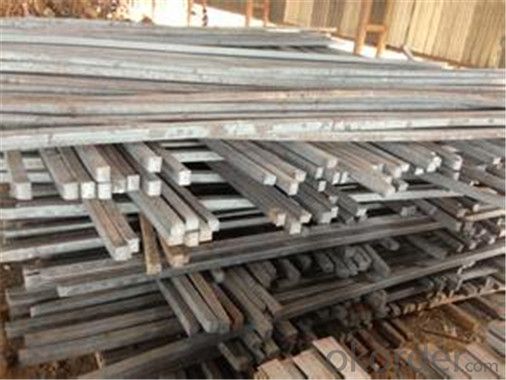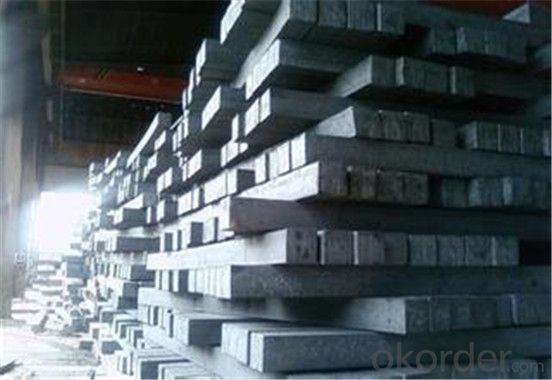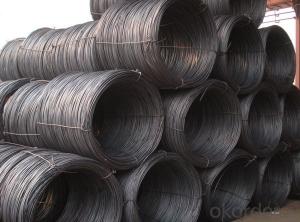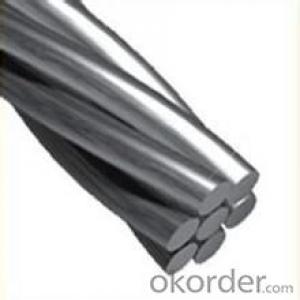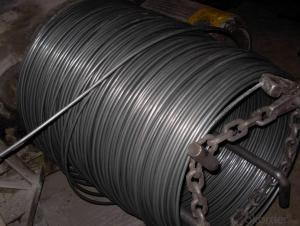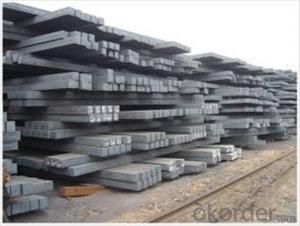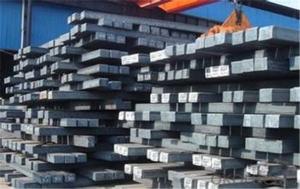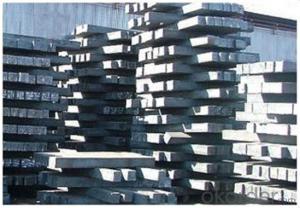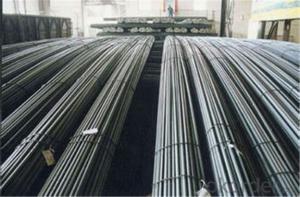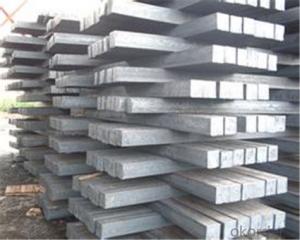Square Steel Billets Hot Sale Q235B/5SP in China
- Loading Port:
- Tianjin
- Payment Terms:
- TT OR LC
- Min Order Qty:
- 800 m.t.
- Supply Capability:
- 45555555 m.t./month
OKorder Service Pledge
OKorder Financial Service
You Might Also Like
Specification
Description of steel billet:
Our company is recognized by ISO9001:2008
1. hot rolled wire rod
2. material: Q195-235
Festures of steel billet:
1. Drawn wire specialist, your wire rod solution
2. ISO9001 Certified Mill &SGS
3. Feature: machinability, high hardness, toughness, corrosion resistant
Specifications of steel billet:
Type | Steel billet / Square steel/ Steel square bar |
Standard grade | 3SP/PS, 5SP/PS, Q195, Q235, Q255, Q275, 20MnSi etc. |
MOQ | 1000 MT |
Technique | Hot rolled |
Size | 50*50mm ~ 160*160mm |
Length | 3~12m |
Packing | Loose packing, in bundle |
Payment terms | T/T, L/C at sight, Usance L/C |
Trade terms | EXW, FOB, CFR, CIF |
Trans terms | FIO, FILO, FLT |
Inspection | Third party inspection accepted |
Delivery time | 15-30 days, according to the quantity |
Applications | carbon structural steel, wire rod, rod, deformed bars, profile steel, machine parts, and steel moulds etc . |
Note | Customized service is available (for sizes,length and chemical components etc.). |
Images of steel billet:
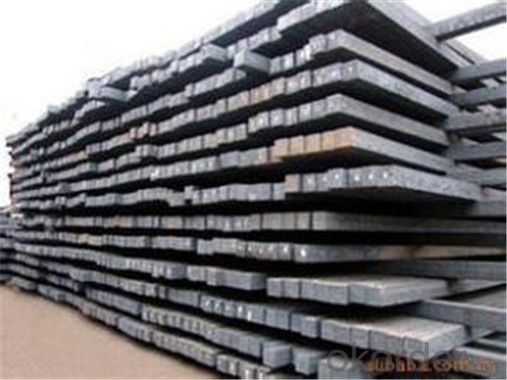
FAQ:
1. What is your package?
Packing situation: standard seaworthy packing or as customer required.
2. How long is the lead time?
Delivery time: 45 days after order confirmed.
3. What payment term do you accept?
Payment: T/T or L/C at sight.
- Q: How is steel wire rod used in the manufacturing of wire forms for medical devices?
- Steel wire rod is used in the manufacturing of wire forms for medical devices as it provides a strong and durable material for creating intricate shapes. The wire rod is first processed through various stages such as annealing, drawing, and coating to achieve the desired properties and finish. These wire forms are then used in medical devices like surgical instruments, catheters, and orthopedic implants, where they serve purposes such as structural support, flexibility, and electrical conductivity.
- Q: How is the steel wire rod market affected by changes in trade policies?
- Changes in trade policies can have a significant impact on the steel wire rod market. Trade policies such as tariffs or quotas can influence the supply and demand dynamics, production costs, and competitiveness of steel wire rod producers. When trade policies impose tariffs on steel wire rod imports, it can increase the cost of importing the product, making it more expensive for domestic manufacturers to source raw materials. This can lead to an increase in the price of steel wire rod in the domestic market, affecting the profitability of manufacturers and potentially reducing the demand for the product. Conversely, if trade policies impose tariffs on steel wire rod exports, it can limit the market access for domestic manufacturers, reducing their ability to sell their products internationally and potentially impacting their revenue. Quotas on steel wire rod imports can also have a significant impact on the market. When quotas are imposed, it limits the quantity of imported steel wire rod that can enter the domestic market. This can lead to a decrease in supply, potentially creating a shortage in the market and driving up prices. On the other hand, if quotas are imposed on steel wire rod exports, it may restrict the ability of domestic manufacturers to access international markets, reducing their market reach and potentially affecting their profitability. Changes in trade policies can also impact the competitiveness of domestic steel wire rod producers. If trade policies favor domestic producers by imposing higher tariffs on imports, it can provide a competitive advantage to domestic manufacturers by making imported steel wire rod more expensive. This can incentivize domestic production and potentially lead to increased investment in the industry. Conversely, if trade policies favor imports by imposing higher tariffs on exports, it can hinder the competitiveness of domestic producers, making it difficult for them to compete in international markets. Overall, changes in trade policies can have both positive and negative impacts on the steel wire rod market. The extent of these impacts depends on the specific trade policies implemented and the reactions of market participants.
- Q: How is steel wire rod used in the production of wire for cable trays?
- Wire rod made from steel is an essential element in the manufacturing of wire used for cable trays. The wire rod acts as the raw material from which the wire is produced for cable trays. The initial step involves passing the wire rod through a set of dies to decrease its diameter and increase its length. This drawing process serves to refine the wire rod and enhance its mechanical characteristics, including tensile strength and ductility. Once the wire rod has been drawn, it undergoes further processing to achieve the desired shape and size for cable trays. This may include additional procedures like annealing to improve flexibility and resistance to deformation. To provide corrosion resistance and insulation properties, the wire is then coated with a protective layer such as zinc or PVC. The wire produced from steel wire rod is specifically designed to meet the requirements of cable tray systems. It possesses high tensile strength to support heavy loads and resist bending, ensuring secure containment and protection of electrical cables. The wire's smooth surface and consistent diameter facilitate trouble-free installation and routing of cables within the tray, minimizing the risk of cable damage. In conclusion, steel wire rod plays a crucial role in the production of wire for cable trays. It undergoes a series of processes to transform it into wire with the necessary mechanical properties and coatings. This wire is then utilized in the construction of cable trays, providing a reliable and efficient solution for organizing and safeguarding electrical cables in diverse industrial and commercial applications.
- Q: What are the common applications of low carbon and oil tempered steel wire rod?
- Low carbon and oil tempered steel wire rods are commonly used in a variety of applications. Some of the common applications include manufacturing of springs, wire forms, mechanical fasteners, automotive components, construction materials, and agricultural implements. The low carbon content in the steel wire rod provides excellent formability and weldability, making it suitable for intricate and precise applications. The oil tempering process enhances the strength and durability of the wire, making it ideal for heavy-duty and high-stress applications where resistance to fatigue and deformation is required.
- Q: How is steel wire rod used in the production of wire mesh partitions?
- Steel wire rod is an essential component in the production of wire mesh partitions. Wire mesh partitions are commonly used in various applications such as industrial warehouses, commercial spaces, and even residential areas. Steel wire rod serves as the raw material for manufacturing the wire mesh used in these partitions. The wire rod is typically made of high-quality steel, which offers durability, strength, and resistance to corrosion. These properties are crucial for ensuring the longevity and reliability of the wire mesh partitions. To produce wire mesh partitions, the steel wire rod undergoes a series of manufacturing processes. First, the steel wire rod is drawn through a series of dies to reduce its diameter and increase its length. This process is called wire drawing and results in a thinner and longer wire, which is more suitable for weaving. Once the wire is drawn, it is then fed into a machine that weaves it into a mesh pattern. This weaving process can be done in various patterns, such as plain weave, twill weave, or Dutch weave, depending on the desired characteristics of the wire mesh partition. The weaving process interlocks the wires together, creating a strong and stable mesh structure. After the wire mesh is woven, it may undergo additional processes such as galvanization or coating to enhance its resistance to corrosion or provide a specific finish. Galvanization involves coating the wire mesh with a layer of zinc, which acts as a protective barrier against rust and other environmental factors. Once the wire mesh is ready, it is then cut, shaped, and assembled to form the partitions. The wire mesh is secured to a frame made of metal or other materials, creating a sturdy and secure partition system. These partitions can be customized to fit specific spaces and requirements, providing efficient storage, security, and separation of areas. In summary, steel wire rod is an integral component in the production of wire mesh partitions. It serves as the raw material for manufacturing the wire mesh and provides the strength, durability, and resistance to corrosion required for these partitions. Through various manufacturing processes, the steel wire rod is transformed into a woven mesh pattern, which is then shaped and assembled into wire mesh partitions for a wide range of applications.
- Q: How is the diameter of steel wire rod measured?
- The diameter of a steel wire rod is typically measured using a specialized tool called a micrometer. This tool allows for precise measurement of the wire's diameter by capturing the wire between its jaws and providing an accurate reading on a calibrated scale.
- Q: How are steel wire rods used in the production of wire hangers?
- Steel wire rods are used in the production of wire hangers as the primary material. These rods are processed through various manufacturing techniques such as drawing, straightening, and cutting to create the desired length and thickness of wire needed for the hangers. The wire rods serve as the structural backbone of the hangers, providing strength and durability to support and hold clothes.
- Q: How is steel wire rod used in the manufacturing of wire rope baskets?
- Steel wire rod is used in the manufacturing of wire rope baskets as it serves as the primary material for creating the wire ropes. The steel wire rod is first drawn into wires of the required diameter, which are then twisted and braided together to form the wire rope. This wire rope provides the structural strength and durability necessary for wire rope baskets to securely hold and transport various items.
- Q: What are the common applications of low carbon steel wire rod?
- Due to its advantageous properties, low carbon steel wire rod finds extensive use across a wide range of applications. Some common uses of this wire rod include: 1. Construction: The construction industry widely employs low carbon steel wire rod for various purposes. It is commonly utilized to reinforce concrete structures like beams, columns, and slabs. The wire rod's high tensile strength and ductility make it an ideal choice for reinforcement. 2. Manufacturing: Various manufacturing industries extensively utilize low carbon steel wire rod in the production of different products. It is commonly employed in manufacturing nails, screws, bolts, and other fasteners due to its exceptional formability and strength. Additionally, wire mesh, wire ropes, and cables are produced using this wire rod. 3. Automotive industry: The automotive industry also utilizes low carbon steel wire rod for various applications. It is employed in the manufacturing of parts such as springs, suspension systems, and tire cords. The wire rod's flexibility, strength, and durability make it suitable for these applications. 4. Agriculture: In the agricultural sector, low carbon steel wire rod is commonly used for constructing fences and wire mesh. It imparts durability and strength to fencing systems, ensuring the security of livestock and crops. Additionally, it is utilized for making trellises and support structures for plants. 5. Household applications: Low carbon steel wire rod also finds use in various household applications. It is employed in the production of hangers, racks, and shelves due to its ability to withstand heavy loads. Additionally, kitchen utensils, wire baskets, and other household items are manufactured using this wire rod. In summary, low carbon steel wire rod is a versatile material that finds application in diverse industries and contexts. Its properties, including formability, strength, and durability, establish it as the preferred choice for numerous manufacturing and construction purposes.
- Q: What are the different surface defects that can affect the thermal conductivity of steel wire rod?
- There are several surface defects that can affect the thermal conductivity of steel wire rod, including scale, rust, pits, scratches, and surface contamination. These defects can create barriers for heat transfer, reducing the overall thermal conductivity of the wire rod.
Send your message to us
Square Steel Billets Hot Sale Q235B/5SP in China
- Loading Port:
- Tianjin
- Payment Terms:
- TT OR LC
- Min Order Qty:
- 800 m.t.
- Supply Capability:
- 45555555 m.t./month
OKorder Service Pledge
OKorder Financial Service
Similar products
Hot products
Hot Searches
Related keywords
